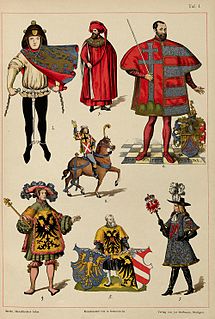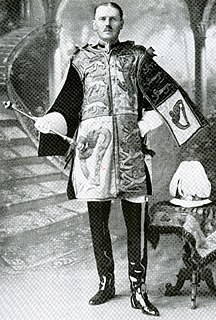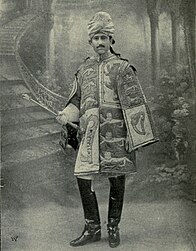
The Right Honourable the Lord Lyon King of Arms, the head of Lyon Court, is the most junior of the Great Officers of State in Scotland and is the Scottish official with responsibility for regulating heraldry in that country, issuing new grants of arms, and serving as the judge of the Court of the Lord Lyon, the oldest heraldic court in the world that is still in daily operation.

The College of Arms, or Heralds' College, is a royal corporation consisting of professional officers of arms, with jurisdiction over England, Wales, Northern Ireland and some Commonwealth realms. The heralds are appointed by the British Sovereign and are delegated authority to act on behalf of the Crown in all matters of heraldry, the granting of new coats of arms, genealogical research and the recording of pedigrees. The College is also the official body responsible for matters relating to the flying of flags on land, and it maintains the official registers of flags and other national symbols. Though a part of the Royal Household of the United Kingdom, the College is self-financed, unsupported by any public funds.

An officer of arms is a person appointed by a sovereign or state with authority to perform one or more of the following functions:

King of Arms is the senior rank of an officer of arms. In many heraldic traditions, only a king of arms has the authority to grant armorial bearings and sometimes certify genealogies and noble titles. In other traditions, the power has been delegated to other officers of similar rank.

The Delhi Durbar was an Indian imperial-style mass assembly organized by the British at Coronation Park, Delhi, India, to mark the succession of an Emperor or Empress of India. Also known as the Imperial Durbar, it was held three times, in 1877, 1903, and 1911, at the height of the British Empire. The 1911 Durbar was the only one that a sovereign, George V, attended. The term was derived from the common Mughal term durbar.

Sir Albert William Woods was an English officer of arms, who served as Garter Principal King of Arms from 1869 to 1904. The Woods family has a strong tradition of service at the College of Arms. Albert Woods was the son of Sir William Woods, Garter King of Arms from 1838 until his death in 1842. Likewise, the grandson of Albert Woods was Sir Gerald Woods Wollaston, who also rose to the rank of Garter King of Arms and served there from 1930 until 1944.

New Zealand Herald of Arms Extraordinary is the officer of arms responsible for the regulation of heraldry in New Zealand. Although affiliated with the College of Arms in London, the New Zealand Herald lives and works in New Zealand, and is not a member of the College Chapter. The current New Zealand Herald of Arms Extraordinary is Phillip Patrick O’Shea.

The law of heraldic arms governs the "bearing of arms", that is, the possession, use or display of arms, also called coats of arms, coat armour or armorial bearings. Although it is believed that the original function of coats of arms was to enable knights to identify each other on the battlefield, they soon acquired wider, more decorative uses. They are still widely used today by countries, public and private institutions and by individuals. The earliest writer on the law of arms was Bartolus de Saxoferrato. The officials who administer these matters are called pursuivants, heralds, or kings of arms. The law of arms is part of the law in countries which regulate heraldry, although not part of common law in England and in countries whose laws derive from English law.

A herald, or a herald of arms, is an officer of arms, ranking between pursuivant and king of arms. The title is commonly applied more broadly to all officers of arms.

John Philip Brooke Brooke-Little was an English writer on heraldic subjects, and a long-serving herald at the College of Arms in London. In 1947, while still a student, Brooke-Little founded the Society of Heraldic Antiquaries, now known as the Heraldry Society and recognised as one of the leading learned societies in its field. He served as the society's chairman for 50 years and then as its President from 1997 until his death in 2006.

Sir Alexander Colin Cole was a long serving officer of arms at the College of Arms in London. Eventually, he would rise to the rank of Garter Principal King of Arms, the highest heraldic office in England.
(Arthur) Oswald Barron was a journalist and scholar on heraldic and genealogical subjects.

General Sir William Eliot Peyton, was a British Army officer who served as Military Secretary to the British Expeditionary Force from 1916 to 1918. He was also Delhi Herald of Arms Extraordinary at the time of the Delhi Durbar of 1911.

Major General Nawab Sir Umar Hayat Khan Tiwana, was a Rajput soldier of the Indian Empire, one of the largest landholders in the Punjab, and an elected member of the Council of State of India.
Khan Sahib, Qazi Zafar Hussain came from a qadi's family which had, since the 16th century, been prominent among the landed aristocracy of the Soon Valley. He belonged to Awans tribe of ancient repute. He was awarded the title of Khan Sahib by the British Crown. This was a formal title, a compound of khan (leader) and sahib (Lord), which was conferred in Mughal Empire and British India. Although his father, Qazi Mian Muhammad Amjad forbade his descendants to establish Dargah, he was considered Sajjada Nashin by the people of his area. "Sajjada nashins" David Gilmartin asserts, "claimed to be the descendants of the Sufi, 'saints', intermediaries between the Faithful and their God, and this cut against the grain of Islamic orthodoxy ... in kind, of their special religious status, these sajjada nashins had become men of local standing in their own right." However he never claimed to be a Sajjada Nashin. In the Punjab, the sajjada nashin or pir families were not so rich in terms of land as the great land lords of Punjab but these sajjada nashin or pir families exerted great political and religious influence over the people. The British could not administer the area without their help and no political party could win the election without their help.
When the All-India Muslim League was founded at Dacca, on 30 December 1906 at the occasion of the annual All India Muhammadan Educational Conference, It was participated by the Muslim leaders from Punjab, i.e., Sir Mian Muhammad Shafi, Mian Fazl-i-Hussain, Abdul Aziz, Khawaja Yusuf Shah and Sh. Ghulam Sadiq. Earlier Mian Muhammad Shafi organised a Muslim Association in early 1906, but when the All-India Muslim League was formed, he established its powerful branch in the Punjab of which he became the general secretary. Shah Din was elected as its first president. This branch, organised in November 1907, was known as the Punjab Provincial Muslim League.
Qazi Mazhar Qayyum 'Raees-Azam Naushera', is a Pakistani politician. He came from a qadi's family that had been prominent among the landed aristocracy of the Soon Valley since the 16th century.

The Court of the Lord Lyon is a standing court of law which regulates heraldry in Scotland. The Lyon Court maintains the register of grants of arms, known as the Public Register of All Arms and Bearings in Scotland, as well as records of genealogies.

Nawab Muhammad Hayat Khan Khattar (1833–1901) was an Indian Muslim who served the Government of British India and rose to considerable distinction.

New Zealand heraldry basically follows the British heraldic traditions.

















